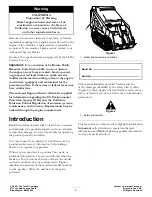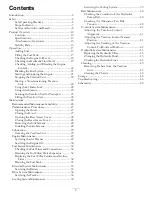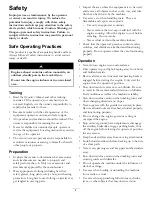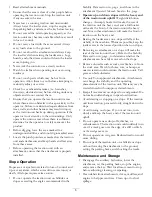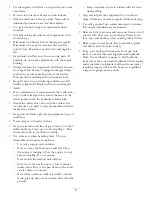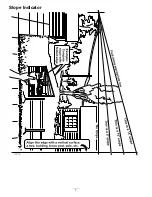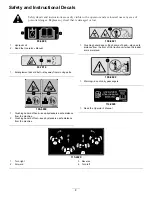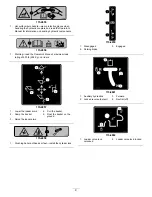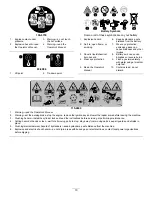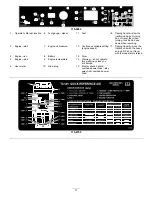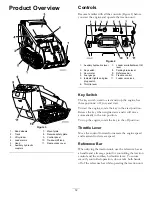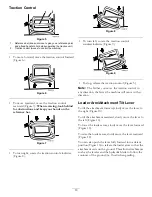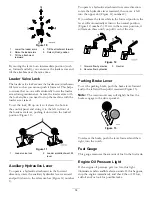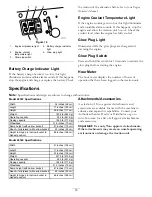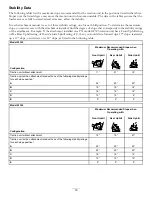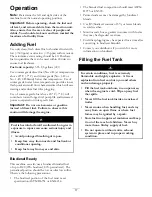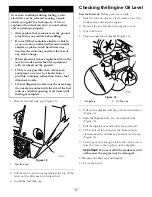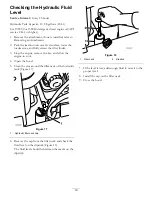
•
Read all attachment manuals.
•
Ensure that the area is clear of other people before
operating the traction unit. Stop the traction unit
if anyone enters the area.
•
Never leave a running traction unit unattended.
Always lower the loader arms, stop the engine, set
the parking brake, and remove the key before leaving.
•
Do not exceed the rated operating capacity, as the
traction unit may become unstable which may result
in loss of control.
•
Do not carry a load with the arms raised. Always
carry loads close to the ground.
•
Do not over-load the attachment and always keep
the load level when raising the loader arms. Logs,
boards, and other items could roll down the loader
arms, injuring you.
•
Never jerk the controls; use a steady motion.
•
Watch for traffic when operating near or crossing
roadways.
•
Do not touch parts which may be hot from
operation. Allow them to cool before attempting to
maintain, adjust, or service.
•
Check for overhead clearances (i.e. branches,
doorways, electrical wires) before driving under any
objects and do not contact them.
•
Ensure that you operate the traction unit in areas
where there are no obstacles in close proximity to the
operator. Failure to maintain adequate distance from
trees, walls, and other barriers may result in injury
as the traction unit backs up during operation if the
operator is not attentive to the surroundings. Only
operate the unit in areas where there is sufficient
clearance for the operator to safely maneuver the
product.
•
Before digging, have the area marked for
underground utilities, and do not dig in marked areas.
•
Locate the pinch point areas marked on the traction
unit and attachments and keep hands and feet away
from these areas.
•
Before operating the traction unit with an
attachment, ensure that the attachment is properly
installed.
Slope Operation
Slopes are a major factor related to loss-of-control and
tip-over accidents, which can result in severe injury or
death. All slopes require extra caution.
•
Do not operate the traction unit on hillsides or
slopes exceeding the angles recommended in the
Stability Data section in , page , and those in the
attachment
Operator’s Manual
. See also the , page .
•
Operate up and down slopes with the heavy end
of the traction unit uphill.
Weight distribution
changes. An empty bucket will make the rear of
the traction unit the heavy end, and a full bucket
will make the front of the traction unit the heavy
end. Most other attachments will make the front of
traction unit the heavy end.
•
Raising the loader arms on a slope will affect the
stability of the machine. Whenever possible, keep the
loader arms in the lowered position when on slopes.
•
Removing an attachment on a slope will make the
rear of the traction unit heavy. Refer to the Stability
Data section in , page , to determine whether the
attachment can be safely removed on the slope.
•
Remove obstacles such as rocks, tree limbs, etc. from
the work area. Watch for holes, ruts, or bumps, as
uneven terrain could overturn the traction unit. Tall
grass can hide obstacles.
•
Use only Toro-approved attachments. Attachments
can change the stability and the operating
characteristics of the traction unit. Warranty may be
voided if used with unapproved attachments.
•
Keep all movements on slopes slow and gradual. Do
not make sudden changes in speed or direction.
•
Avoid starting or stopping on a slope. If the traction
unit loses traction, proceed slowly, straight down the
slope.
•
Avoid turning on slopes. If you must turn, turn
slowly and keep the heavy end of the traction unit
uphill.
•
Do not operate near drop-offs, ditches, or
embankments. The traction unit could suddenly turn
over if a track goes over the edge of a cliff or ditch,
or if an edge caves in.
•
Do not operate on wet grass. Reduced traction could
cause sliding.
•
Do not park the traction unit on a hillside or slope
without lowering the attachment to the ground,
setting the parking brake, and chocking the tracks.
Maintenance and Storage
•
Disengage the auxiliary hydraulics, lower the
attachment, set the parking brake, stop the engine,
and remove the key. Wait for all movement to stop
before adjusting, cleaning, or repairing.
•
Clean debris from attachments, drives, mufflers, and
engine to help prevent fires. Clean up oil or fuel
spillage.
5
Содержание 22319
Страница 7: ...Slope Indicator 7...
Страница 49: ...Schematics G007388 Electrical Schematic Rev B 49...
Страница 50: ...Hydraulic Schematic Rev A 50...
Страница 51: ...Notes 51...


